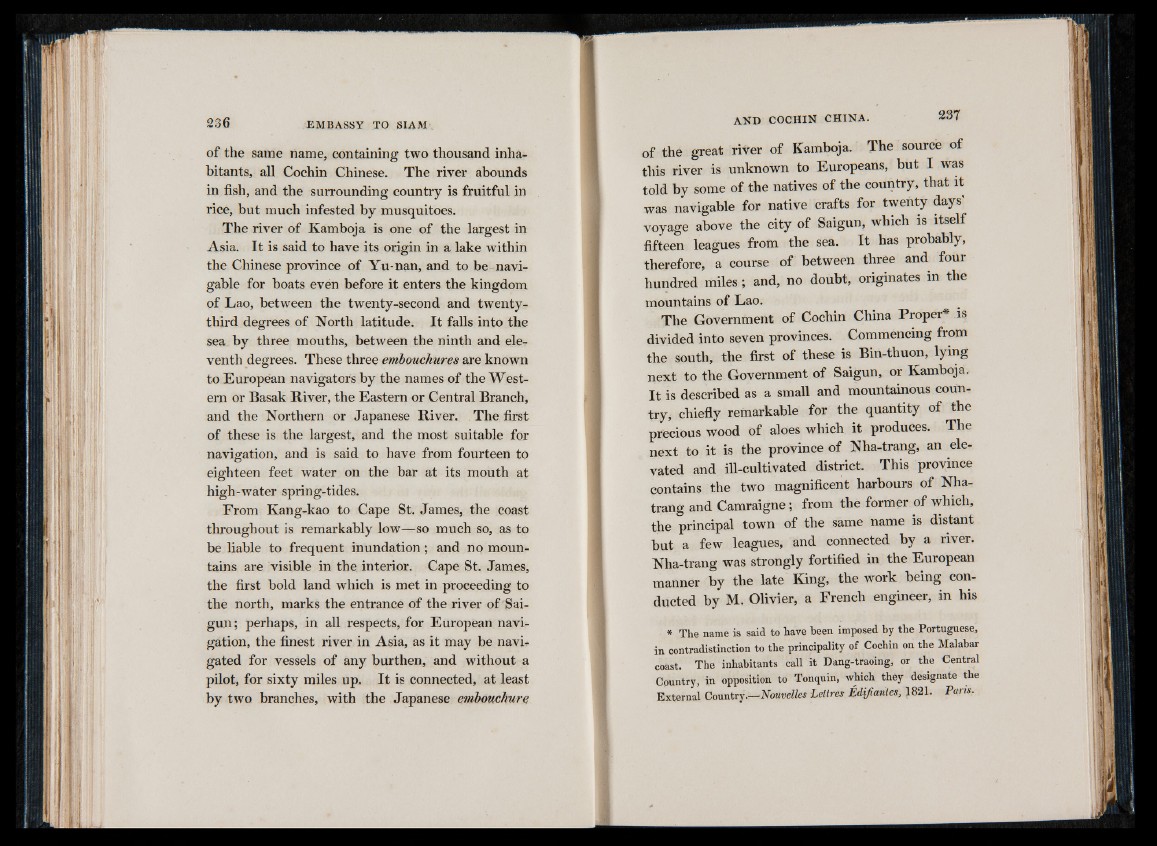
of the same name, containing two thousand inhabitants,
all Cochin Chinese. The river abounds
in fish, and the surrounding country is fruitful in
rice, but much infested by musquitoes.
The river of Kamboja is one of the largest in
Asia. It is said to have its origin in a lake within
the Chinese province of Yu-nan, and to be-navigable
for boats even before it enters the kingdom
of Lao, between the twenty-second and twenty-
third degrees of North latitude. I t falls into the
sea by three mouths, between the ninth and eleventh
degrees. These three embouchures are known
to European navigators by the names of the Western
or Basak River, the Eastern or Central Branch,
and the Northern or Japanese River. The first
of these is the largest, and the most suitable for
navigation, and is said to have from fourteen to
eighteen feet water on the bar at its mouth at
high-water spring-tides.
From Kang-kao to Cape St. James, the coast
throughout is remarkably low—so much so, as to
be liable to frequent inundation; and no mountains
are visible in the interior. Cape St. James,
the first bold land which is met in proceeding to
the north, marks the entrance of the river of Sai-
gun; perhaps, in all respects, for European navigation,
the finest river in Asia, as it may be navigated
for vessels of any burthen, and without a
pilot, for sixty miles up. I t is connected, at least
by two branches, with the Japanese etmbouchurq
of the great river of Kamboja. The source of
this river is unknown to Europeans, but I was
told by some of the natives of the country, that it
was navigable for native crafts for twenty days'
voyage above the city of Saigun, which is itself
fifteen leagues from the sea. I t has probably,
therefore, a course of between three and four
hundred miles ; and, no doubt, originates in the
mountains of Lao.
The Government of Cochin China Proper* is
divided into seven provinces. Commencing from
the south, the first of these is Bin-thuon, lying
next to the Government of Saigun, or Kamboja.
I t is described as a small and mountainous country,
chiefly remarkable for the quantity of the
precious wood of aloes which it produces. The
next to it is the province of Nha-trang, an elevated
and ill-cultivated district. This province
contains the two magnificent harbours of Nha-
trang and Camraigne ; from the former of which,
the principal town of the same name is distant
but a few leagues, and connected by a river.
Nha-trang was strongly fortified in the European
manner by the late King, the work being conducted
by M. Olivier, a French engineer, in his
* The name is said to have been imposed by the Portuguese,
in contradistinction to the principality of Cochin on the Malabar
coast. The inhabitants call it Dang-traoing, or the Central
Country, in opposition to Tonquin, which they designate the
External Country.—Nouvelles Lettres Édifiantes, 1821. Paris,